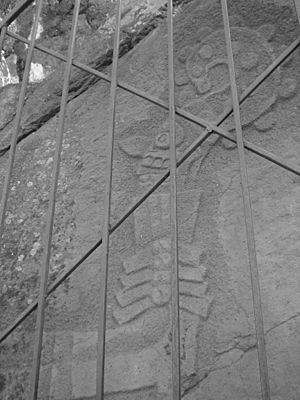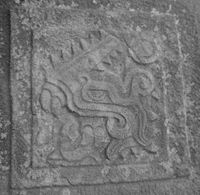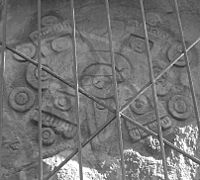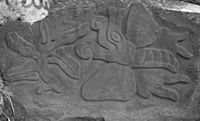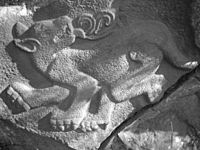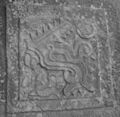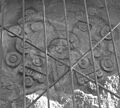Cuahilama facts for kids
| Name: | Chuahilama Hill Ceremonial Center |
| Location | Xochimilco, Mexico City |
| Coordinates | 19°14′30″N 99°04′15″W / 19.24167°N 99.07083°W |
| Culture | Xochimilcas |
| Period | Late mesoamerican Preclassical - 1200–1500 CE. |
| Foundation | |
| Decline | |
| Language | |
| INAH Official Page | Non existent |
Cuahilama is a special hill and an old archaeological site in Mexico City. It's located near Santa Cruz Acalpixca, in the Xochimilco area. Long ago, this hill was a very important place for ceremonies. You can still see ancient pictures carved into the rocks there.
Contents
Where is Cuahilama?
Cuahilama Hill is found on "Prolongación 2 de Abril" Street. It's close to the town of Santa Cruz Acalpixca. This area is in the Xochimilco borough, in the southeastern part of Mexico City.
A Look at History
The area around Xochimilco has been home to people for a very long time. Early groups like the Cuicuilco and Tlatilco lived here between 2500 and 200 BCE. Later, the Teotihuacano people were here from about 200 BCE to 700 CE.
Around 1254 CE, a group called the Xochimilcas arrived. They were one of the first Nahuatl-speaking tribes to come from a place called Aztlán in the north. Their first leader, Acatonalli, founded a village on Cuahilama Hill.
The Xochimilcas were skilled farmers. When they faced food shortages, Acatonalli suggested a clever idea. They started building floating gardens called Chinampas on the lake. These were made by placing wooden rods filled with organic dirt over the water. This farming method is still used today! They grew important foods like corn, chili, beans, and pumpkin, as well as beautiful flowers.
From Cuahilama, the Xochimilcas spread out. They lived along the southern shore of the Xochimilco lake. They also settled on small islands like Tláhuac and Míxquic. Their influence reached towards the mountains of Sierra de Ajusco-Chichinauhtzin. Between 1450 and 1521, Santa Cruz Acalpixca was a small but important village. This was when many of the rock carvings, called petroglyphs, were made.
The Ancient Site
Cuahilama means "old woman head" in the Nahuatl language. This site had an observatory, a special shrine, and an ancient path. This path led to the top of the hill, where ceremonies likely took place. There were also farming terraces and areas where people lived.
This ancient settlement shows features of the Aztec culture. It was probably a ceremonial center for celebrations about farming and the sun. People believed these events were linked to the calendar and stars. Every 52 years, the Xochimilcas held a special "New Fire" ceremony. This was to make sure the new sun would arrive safely.
The site is famous for its Petroglyphs. These are ancient carvings on the hillside rocks. They were made between 1200 and 1500 CE. These carvings show the beliefs of the Xochimilcas. They were used in ceremonies and to honor their gods. The petroglyphs often show stars, groups of stars (constellations), and figures related to making the land fertile.
Important Petroglyphs
Here are some of the interesting carvings you can find at Cuahilama:
- Ollín Nahui (fourth movement): This carving represents the current "Fifth Sun" era. The Xochimilcas believed there were four earlier "Suns" or stages of the world. It also shows the four directions of the universe and four calendar numbers.
- The Huetzalin (the Priest): This figure represents a priest who guided the Xochimilcas.
- Ze Cipactli (One crocodile): This carving stands for the first day of the ancient Mesoamerican calendar.
- Itzpapalotl (Obsidian Butterfly): This butterfly symbolizes poetry, songs, and dance. The way a butterfly moves was seen as a symbol of the Sun's movement.
- Xonecuitl (curly foot): This represents the staff or baton of the god Quetzalcoatl. It is also linked to the Milky Way galaxy.
- Océlotl (jaguar): This is the fourteenth day of the solar calendar month. It is a symbol of war. Because jaguars hunt at night, they were seen as the animal form of the god Tezcatlipoca.
- Huacalxochitl: This was a sacred plant for the Xochimilcas. It was used as medicine and was important in ceremonies. Warriors and leaders would wear it as decoration.
- Acocoxochitl (Dahlia Flower): Its name means "hollow stem filled with water flower." This flower was used for decoration, food, medicine, and ceremonies. It is now Mexico's national flower.
- Yoloxochitl (Magnolia Flower): Another important flower.
- Nahualapa: This is a stone map. It shows the Xochimilco Lake, many water springs, buildings with stairs, and paths.
- Ocelocóhuatl (Also called Cihuacoatl): In Aztec mythology, Cihuacoatl was a goddess of motherhood and fertility.
- The “yaoquizqui (The warrior): This carving represents a warrior.
What's Happening Now?
Sadly, the archaeological site of Cuahilama is facing problems. Some people damage the site, and there's not enough protection from authorities or even the community.
The ancient remains are getting damaged. This is happening because the city is growing, and there isn't enough care from local authorities or the Instituto Nacional de Antropología e Historia (INAH). Even though people have complained about valuable pieces being stolen, not much has been done. The petroglyphs are not protected and have been damaged by graffiti.
The land where the site is located is privately owned. However, the owners don't have official land titles, only private agreements. This makes it hard for the government to buy the land and protect it properly.
Why is this Site Important?
The INAH has said that Cuahilama is not a "relevant" site compared to others. They explain that Mexico has over 10,000 archaeological sites, and some are considered more important. However, the petroglyphs at Cuahilama are from the Aztec period. They show gods and represent stars, constellations, and figures linked to fertility. This makes them very valuable for understanding the Xochimilca people.
See also
 In Spanish: Cuahilama (zona arqueológica) para niños
In Spanish: Cuahilama (zona arqueológica) para niños
- List of pre-columbian archaeological sites in Mexico City
Images for kids


